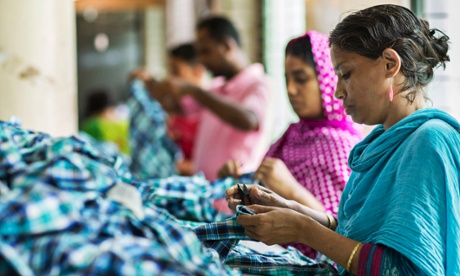
Is a fair wage the same as a living wage?
“Fair wage, decent wage, living wage… it doesn’t matter what you call it, it’s about paying workers enough so that they can cover the basic costs required for a dignified, healthy life,” says Sabita Banerji, Ethical Trading Initiative.
Some countries have a legal minimum wage, but this does not always reflect either a living or a fair wage, and there is a difference between the two, explains IndustriALL Global Union’s Monika Kemperle. “A living wage is a wage on which a worker and his or her family can live off. A fair wage does not always include the living costs for the dependents.”
So, who should take responsibility for paying more for fairer wages: factories, brands or consumers?
All of them. No one player in the fashion industry can ensure garment workers are paid a fair wage – change can only come through the combined efforts of factory owners, brands and consumers.
“The factory owners must take labour cost into their calculations and make sure their workers get a living wage. Brands need then to accept that labour costs are included in the manufacturing cost. And consumers must be aware of the real price of a piece of clothing,” says Kemperle.
Daniel Vaughan-Whitehead, senior economist at the International Labour Office, adds: “There is a need to change the mentalities of suppliers in the sense that they may have the tendency to treat wages as the adjustment variable at the end of the chain, once they have paid other production costs.” Through training and increased awareness, paying fair wages should become part of a supplier’s top priorities.
At the same time, however, brands must improve their purchasing practices and give their suppliers the right margin because last-minute orders and peak production months put pressure on suppliers, which results in excessive working hours and low wages.
What about government?
Government is definitely important too. “Both governments and brands have a responsibility and their roles are dependent on each other in many ways,” writes H&M’s social sustainability manager, Gustav Lovén.
“It is also important to understand that the same factories are supplying different brands with very different retail prices. Yet the workers have the same salary, no matter which brand they supply, so this is an industry-wide challenge,” says Lovén. “[Brands] need to work with governments to drive increases of the legal minimum wages. In that way, it can benefit all workers so that all can have a fair living wage, no matter which factory they work in or which brands they supply.”
What would be ideal, writes Banerji, is if the legal minimum wage met the requirements of a living wage.
But won’t brands move production away from countries in which a fair wage has been introduced?
“If these costs go up it would be logical to assume that some brands will look for the next cheap alternative. We have already seen companies move production from China (where wages are increasing) to countries like Cambodia,” says Danielle McMullan, researcher, Business & Human Rights Resource Centre.
“However, recently some brands have said they are willing to factor higher wages into their costs of production in Cambodia, and called on the government there to set the minimum wage at a living wage level.”
Banerji notes that the move away from China has not been as significant as people feared, which suggests that companies do use other criteria besides wages when deciding on production countries, like ensuring stable relationships and cooperation with suppliers. Inditex’s Felix Poza supports this, claiming: “The geographical breakdown of our sourcing is mostly linked with the needs of our business model rather than with specific labour costs in one market.”
Where do unions come into this?
Trade unions can help workers to organise and negotiate their own wages and working conditions through collective bargaining agreements, which Poza believes “reflects the real needs of workers and the real industry conditions”.
However, legislation in many countries isn’t union friendly, which means the principle of freedom of association and core labour standards often aren’t respected. Brands can help here by putting pressure on employers (factory owners) to allow workers to form and join a union.
Will abstaining from fast fashion help factory workers?
Fast fashion can drive down wages because late changes and short-notice demands cause unsteady relationships between brands and suppliers, and unpredictable production schedules. Following this logic, Banerji ponders if fashion magazines, designers, models and fashion shows that encourage fast fashion should also be added to the list of those responsible for improving wages.
Seasonal trends and unsustainable consumption don’t necessarily make fair wages impossible though. “Again, it comes back to the calculations,” says Kemperle. “Maybe the margins will be smaller, but the workers should not pay the price for fast fashion.” And consumers do have some power in helping transition to a fairer garment industry. Lovén calls on all interested customers to ask, “What is the brand I am buying from doing to achieve fair living wages for the workers?”
The sustainable fashion hub is funded by H&M. All content is editorially independent except for pieces labelled ‘brought to you by’. Find out more here.
Join the community of sustainability professionals and experts. Become a GSB member to get more stories like this direct to your inbox.

